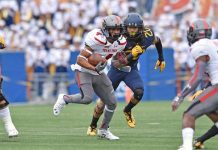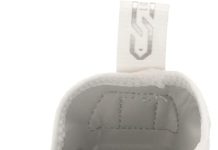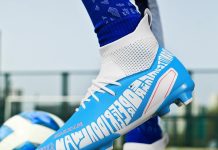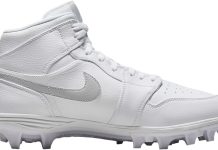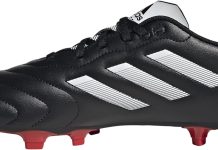Football cleats are an essential piece of equipment that can greatly impact performance on the field. As avid fans of the sport, finding the perfect pair of football cleats can be quite the task, with a plethora of options available in the market. From traction and fit to durability and style, there are various factors to consider before making a purchase. In this article, we will explore the key elements that one should look for when buying football cleats, ensuring that your feet are not only comfortable but also optimized for success on the gridiron.
Material
Review contents
Leather
Leather is a popular choice for football cleats because of its durability and natural flexibility. It provides a comfortable fit, molds to the shape of the foot, and offers excellent support. Leather cleats are known for their superior traction, which is essential for quick stops and starts on the field. They also offer good protection against the elements and provide a classic, stylish look. However, leather cleats can be quite expensive and require regular maintenance to keep them in top condition.
Synthetic
Synthetic materials are commonly used in football cleats due to their lightweight nature and affordability. They are often made from materials like polyurethane or synthetic leather, which offer durability and water resistance. Synthetic cleats are typically easier to clean and require less maintenance compared to leather options. They also tend to break in quickly, offering immediate comfort on the field. However, synthetic cleats may not offer the same level of breathability as leather cleats and may not conform to the foot as well.
Mesh
Mesh is a popular option for football cleats because of its breathability and lightweight design. Cleats with mesh uppers allow air to circulate more freely, keeping the feet cool and dry during intense gameplay. They are also very flexible, allowing for natural foot movement. Mesh cleats are often more affordable and easier to clean compared to leather or synthetic options. However, they may not provide the same level of support and protection as other materials, making them better suited for players who value lightness and agility over robustness.
Style
Low-cut
Low-cut cleats offer maximum agility and allow for quick changes in direction. They sit below the ankle, providing a greater range of motion. These cleats are ideal for players who prioritize speed and maneuverability, such as wide receivers and defensive backs. However, they offer less ankle support and protection compared to higher-cut styles.
Mid-cut
Mid-cut cleats provide a balance between mobility and support. They sit at the middle of the ankle, offering moderate protection and stability. These cleats are suitable for a wide range of positions, including running backs, linebackers, and quarterbacks. Mid-cut cleats offer a good compromise between agility and ankle support, making them a popular choice among many football players.
High-cut
High-cut cleats offer the most ankle support and protection. They extend above the ankle, providing stability and reducing the risk of sprains and other injuries. These cleats are commonly preferred by linemen and other players who engage in physical contact and require extra support. High-cut cleats sacrifice some agility for added safety and are often heavier than low-cut or mid-cut options.
Fit
Size
Ensuring the right fit is crucial when buying football cleats. Cleats that are too small can cause discomfort and blisters, while cleats that are too large can lead to foot instability and reduced performance. It is essential to measure your foot accurately and refer to the manufacturer’s sizing guide. Remember that different brands may have slight variations in sizing, so try on different models to find the perfect fit for you.
Width
In addition to size, considering the width of the cleats is important for a comfortable fit. Cleats that are too narrow can cause pain and restrict foot movement, while cleats that are too wide can lead to lack of support and stability. Many cleats are available in different width options, so take the time to find the width that best suits the shape of your foot.
Arch Support
Players with high arches or flat feet may benefit from cleats with proper arch support. Arch support helps distribute weight evenly across the foot, reducing the risk of foot fatigue and injuries. Different cleat models offer varying levels of arch support, so pay attention to this aspect when choosing your cleats.
Traction
Cleat Type
Choosing the right cleat type is crucial for optimal traction on the field. The most common types of football cleats include molded, detachable, and turf.
Molded cleats are permanently attached to the shoe and provide reliable traction on various playing surfaces. They have rubber or plastic studs that are molded into the sole of the shoe, offering good grip and stability. Molded cleats are suitable for most field conditions and are typically more affordable than detachable cleats.
Detachable cleats allow players to replace the studs based on the playing surface. They feature screw-in studs, which can be longer for soft or wet fields or shorter for firmer surfaces. Detachable cleats offer superior traction and versatility but tend to be more expensive than molded cleats.
Turf cleats are specifically designed for artificial turf or indoor surfaces. They have numerous small rubber studs that provide excellent grip on these types of playing surfaces. Turf cleats are not suitable for use on natural grass and may cause injury or damage to the field.
Stud Shape
The shape of the studs significantly impacts traction and performance on the field. Different stud shapes are designed for specific playing conditions.
Conical studs are the most common and versatile shape. They provide good all-around traction and allow players to make quick turns and changes in direction.
Blade studs offer excellent stability and grip on natural grass. They are typically longer and narrower than conical studs, providing enhanced traction.
Chevron studs have a V-shaped design and are ideal for quick acceleration and lateral movements. They offer great traction on both natural and artificial surfaces.
Stud Configuration
The configuration of the studs determines the pattern of traction and stability. Common stud configurations include the traditional 12-stud pattern, the 6-stud pattern, and the 4-stud pattern.
The traditional 12-stud pattern features four studs in the heel area and eight in the forefoot. This configuration provides balanced traction and stability for a wide range of playing conditions.
The 6-stud pattern has six evenly spaced studs on the sole. It offers excellent traction while reducing weight and facilitating quick movements.
The 4-stud pattern has only four studs, two at the heel and two at the forefoot. It provides exceptional traction and is often preferred by players who prioritize speed and maneuverability.
Weight
Lightweight
Lightweight football cleats have become increasingly popular amongst players who value speed and agility. They are typically made from synthetic materials and feature innovative design elements to reduce weight without compromising performance. Lightweight cleats allow for quick movements and responsiveness on the field, giving players a competitive edge. However, they may not offer the same level of durability and protection as heavier options.
Midweight
Midweight cleats strike a balance between agility and robustness. They offer a blend of support, durability, and maneuverability that suits a wide range of positions and playing styles. Midweight cleats are often favored by players who value versatility and want a reliable shoe for various field conditions. While they may not provide the same level of speed as lightweight cleats, they offer better durability and protection.
Heavyweight
Heavyweight cleats are designed to provide maximum support and durability. They are often preferred by linemen and other players who engage in physical contact and require additional stability. Heavyweight cleats can withstand the rigors of intense gameplay and offer excellent protection against tackles and impacts. However, due to their robust construction, they may feel heavier and less responsive compared to lighter options.
Comfort
Padding
Cleats with adequate padding offer enhanced comfort and cushioning during play. Look for models with padded collars, tongues, and insoles to provide support and reduce pressure points. Well-padded cleats can help minimize the risk of blisters and keep your feet feeling comfortable throughout the game.
Breathability
When playing football, your feet are bound to sweat, so choosing cleats with good breathability is crucial. Cleats with mesh uppers or perforations allow air to circulate, helping to keep your feet cool and dry. Breathable cleats prevent excessive moisture buildup, reducing the risk of odor and discomfort.
Ankle Support
The level of ankle support provided by the cleats is an essential factor to consider, especially if you have a history of ankle injuries or require extra stability. Look for cleats with padded ankle collars or built-in ankle straps to provide the necessary support and protection. High-cut cleats generally offer the highest level of ankle support, while low-cut cleats offer more freedom of movement.
Durability
Upper Construction
The construction of the upper material greatly affects the durability of the cleats. Look for cleats with sturdy and reinforced uppers that can withstand intense gameplay and regular wear and tear. Leather and synthetic materials are generally more durable compared to mesh, but pay attention to the quality of the construction regardless of the material.
Stitched Sole
Cleats with stitched soles offer added durability and longevity. The stitching helps bond the outsole to the upper, minimizing the risk of separation or detachment. Additionally, stitched soles provide better support and stability, enhancing overall performance on the field.
Reinforced Toe
The toe area of football cleats is often subjected to high impact and frequent kicking. Choosing cleats with a reinforced toe cap or additional protection will help extend their lifespan. Reinforced toes can help prevent premature wear and tear and provide extra durability when handling the demands of the game.
Flexibility
Flex Grooves
Cleats with flex grooves in the outsole allow for natural foot movement and better flexibility. The grooves enhance flexibility in the midfoot and forefoot areas, allowing players to make quick, agile movements on the field. Improved flexibility can help enhance overall performance and reduce the risk of foot fatigue.
Forefoot Flexibility
The flexibility of the forefoot is essential for optimal agility and responsiveness. Cleats with a flexible forefoot allow players to push off the ground more efficiently, facilitating quick acceleration and direction changes. Look for cleats that offer adequate forefoot flexibility to complement your playing style.
Soleplate Material
The material used for the soleplate of the cleats significantly impacts flexibility. Different materials offer varying degrees of flexibility and responsiveness. Lightweight materials like carbon fiber and nylon are known for their flexibility, providing a spring-like response during gameplay. Consider the type of soleplate material and its impact on the overall flexibility and performance of the cleats.
Price
Budget
When shopping for football cleats, it’s important to consider your budget. Football cleats are available at various price points, and it’s possible to find a good pair within a budget range. Look for cleats that offer the essential features you need without unnecessary bells and whistles. Prioritize quality and performance over flashy designs or branding that may drive up the price.
Value for Money
Value for money is a crucial factor to consider when buying football cleats. Evaluate the overall quality, durability, and performance of the cleats in relation to their price. It’s essential to find a balance between affordability and functionality. Reading reviews and seeking recommendations can help you gauge the value for money offered by different cleat models.
Branded vs Generic
Branded football cleats often come with a higher price tag due to their reputation for quality and performance. However, generic or lesser-known brands can also offer reliable and affordable options. When deciding between branded and generic cleats, consider your budget, specific needs, and the reputation of the brand. It’s always a good idea to try on different brands and models to find the best fit and value for money.
Position
Position-specific Cleats
Different positions in football require specific attributes to optimize performance. Some cleat models are designed with certain positions in mind, offering features that cater to the needs of that position. For example, linemen may benefit from cleats with extra traction and stability, while wide receivers may prefer lightweight cleats for speed. Consider the requirements of your position when choosing cleats to maximize your performance on the field.
Versatility
If you play multiple positions or often switch roles on the field, versatile cleats may be your best option. These cleats offer a combination of features that cater to different playing styles and positions. They provide a good balance between speed, support, and traction, making them suitable for various situations. Versatile cleats offer flexibility and adaptability, allowing you to perform optimally regardless of the position you play.
Special Features
Some cleats come with unique features that can enhance your performance or provide additional benefits. For example, some models may incorporate special technologies for improved cushioning, shock absorption, or energy return. Others may offer customizable fit options or personalization features. Consider any special features that might be relevant to your playing style or comfort preferences when selecting your cleats.
In conclusion, there are several factors to consider when buying football cleats. The material, style, fit, traction, weight, comfort, durability, flexibility, price, position, versatility, and special features all play a role in determining the right cleats for your needs. By carefully evaluating each of these aspects and keeping your playing style and position in mind, you can find the perfect pair of football cleats that will enhance your performance on the field. Remember to prioritize comfort, fit, and quality to ensure that your cleats provide the necessary support and protection while allowing you to play at your best.





